run flat FIAT DOBLO COMBI 2018 Owner handbook (in English)
[x] Cancel search | Manufacturer: FIAT, Model Year: 2018, Model line: DOBLO COMBI, Model: FIAT DOBLO COMBI 2018Pages: 272, PDF Size: 23.75 MB
Page 25 of 272

WARNING
15)All adjustments must be made with the
vehicle stationary.
16)Once you have released the
adjustment lever, always check that the
seat is locked on the guides by trying
to move it back and forth. If it is not locked,
the seat may move unexpectedly and
make you lose control of the vehicle.
17)Close the dashboard console before
folding the retractable front passenger seat
to avoid damage.
18)When the passenger seat is folded
away, the space created cannot be used
for loading. When the vehicle is in motion,
you are therefore advised to remove or
secure any objects that might interfere with
the driver.
19)If there is no partition between the cab
and the load compartment, tall objects
or packages may take up part of the
passenger area. Make sure that these
items are well secured by using the
available hooks and that they cannot
interfere with the driver.
20)Close the dashboard console before
folding the front passenger seat to form
a table to avoid damage.
21)While travelling, before using the third
row seats, make sure that the second
row seats are in running position and well
anchored (see the specific label fig. 28.
PARTITIONS
FIXED PANEL PARTITION
(for versions/markets, where provided)
Separates the passenger area from
the load compartment fig. 38.
For versions fitted with three-seater
front bench seat, the guard has the
retractor fig. 39 for the central rear seat
belt.FIXED GLAZED
PARTITION
(for versions/markets, where provided)
This has a central window so you
can keep an eye on your load fig. 40.
For versions fitted with three-seater
front bench seat, the guard has the
retractor fig. 39 for the central rear seat
belt.
SPLIT ROTATING
PARTITION
(for versions/markets, where provided)
Should it be necessary to transport
long, bulky loads, the passenger side
panel can be removed and fixed to the
driver’s side, as follows fig. 41:
lay the foldaway passenger seat flat
(see previous pages);
38F0V0102
39F0V0620
40F0V0103
23
Page 50 of 272
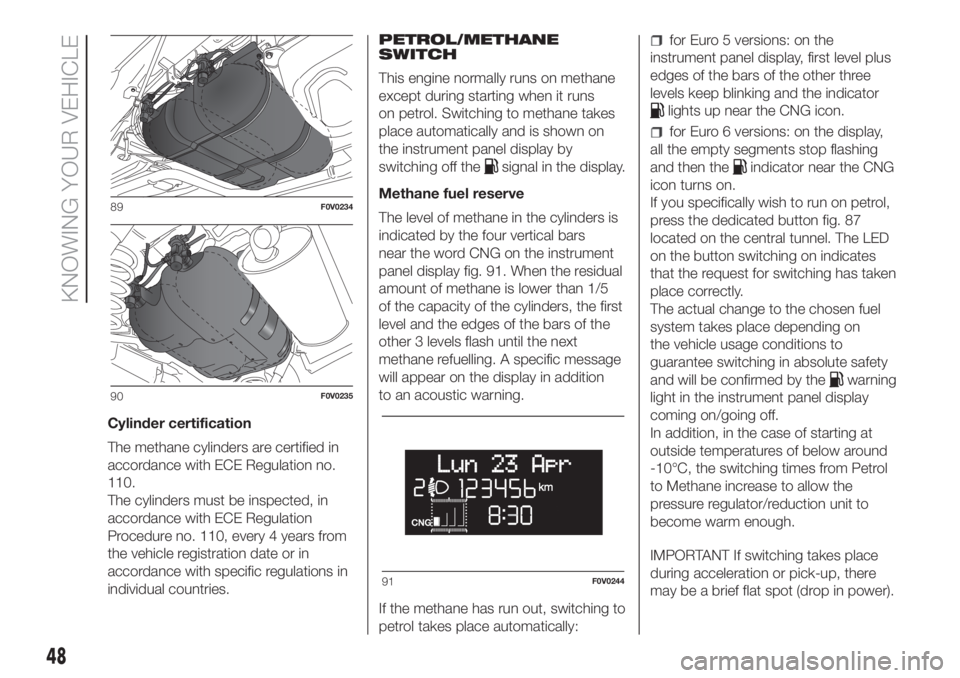
Cylinder certification
The methane cylinders are certified in
accordance with ECE Regulation no.
110.
The cylinders must be inspected, in
accordance with ECE Regulation
Procedure no. 110, every 4 years from
the vehicle registration date or in
accordance with specific regulations in
individual countries.PETROL/METHANE
SWITCH
This engine normally runs on methane
except during starting when it runs
on petrol. Switching to methane takes
place automatically and is shown on
the instrument panel display by
switching off the
signal in the display.
Methane fuel reserve
The level of methane in the cylinders is
indicated by the four vertical bars
near the word CNG on the instrument
panel display fig. 91. When the residual
amount of methane is lower than 1/5
of the capacity of the cylinders, the first
level and the edges of the bars of the
other 3 levels flash until the next
methane refuelling. A specific message
will appear on the display in addition
to an acoustic warning.
If the methane has run out, switching to
petrol takes place automatically:
for Euro 5 versions: on the
instrument panel display, first level plus
edges of the bars of the other three
levels keep blinking and the indicator
lights up near the CNG icon.
for Euro 6 versions: on the display,
all the empty segments stop flashing
and then the
indicator near the CNG
icon turns on.
If you specifically wish to run on petrol,
press the dedicated button fig. 87
located on the central tunnel. The LED
on the button switching on indicates
that the request for switching has taken
place correctly.
The actual change to the chosen fuel
system takes place depending on
the vehicle usage conditions to
guarantee switching in absolute safety
and will be confirmed by the
warning
light in the instrument panel display
coming on/going off.
In addition, in the case of starting at
outside temperatures of below around
-10°C, the switching times from Petrol
to Methane increase to allow the
pressure regulator/reduction unit to
become warm enough.
IMPORTANT If switching takes place
during acceleration or pick-up, there
may be a brief flat spot (drop in power).
89F0V0234
90F0V0235
91F0V0244
48
KNOWING YOUR VEHICLE
Page 109 of 272
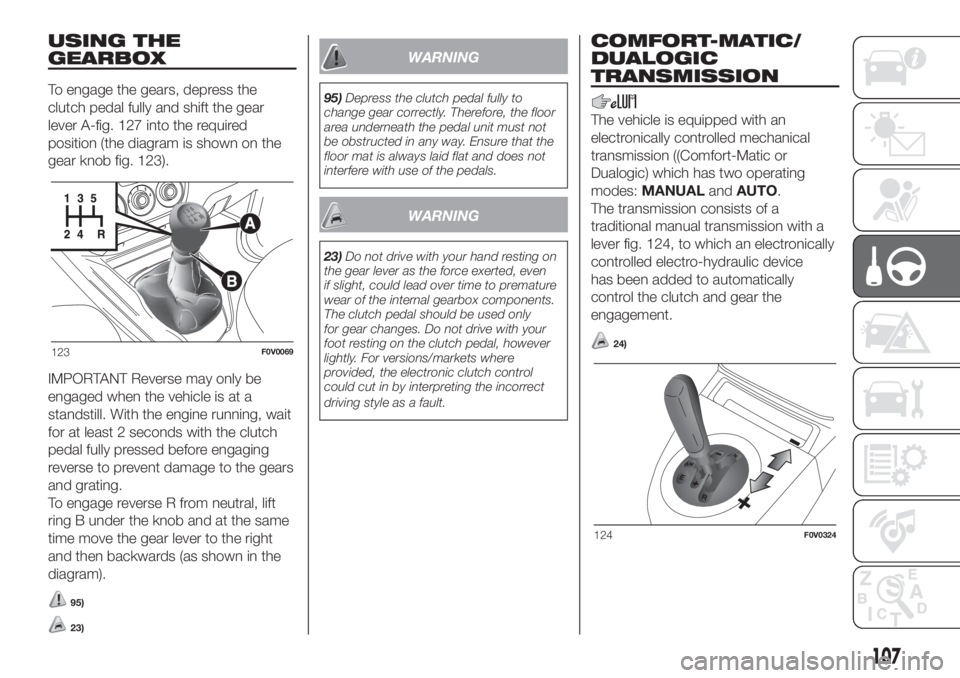
USING THE
GEARBOX
To engage the gears, depress the
clutch pedal fully and shift the gear
lever A-fig. 127 into the required
position (the diagram is shown on the
gear knob fig. 123).
IMPORTANT Reverse may only be
engaged when the vehicle is at a
standstill. With the engine running, wait
for at least 2 seconds with the clutch
pedal fully pressed before engaging
reverse to prevent damage to the gears
and grating.
To engage reverse R from neutral, lift
ring B under the knob and at the same
time move the gear lever to the right
and then backwards (as shown in the
diagram).
95)
23)
WARNING
95)Depress the clutch pedal fully to
change gear correctly. Therefore, the floor
area underneath the pedal unit must not
be obstructed in any way. Ensure that the
floor mat is always laid flat and does not
interfere with use of the pedals.
WARNING
23)Do not drive with your hand resting on
the gear lever as the force exerted, even
if slight, could lead over time to premature
wear of the internal gearbox components.
The clutch pedal should be used only
for gear changes. Do not drive with your
foot resting on the clutch pedal, however
lightly. For versions/markets where
provided, the electronic clutch control
could cut in by interpreting the incorrect
driving style as a fault.
COMFORT-MATIC/
DUALOGIC
TRANSMISSION
The vehicle is equipped with an
electronically controlled mechanical
transmission ((Comfort-Matic or
Dualogic) which has two operating
modes:MANUALandAUTO.
The transmission consists of a
traditional manual transmission with a
lever fig. 124, to which an electronically
controlled electro-hydraulic device
has been added to automatically
control the clutch and gear the
engagement.
24)123F0V0069
124F0V0324
107
Page 113 of 272
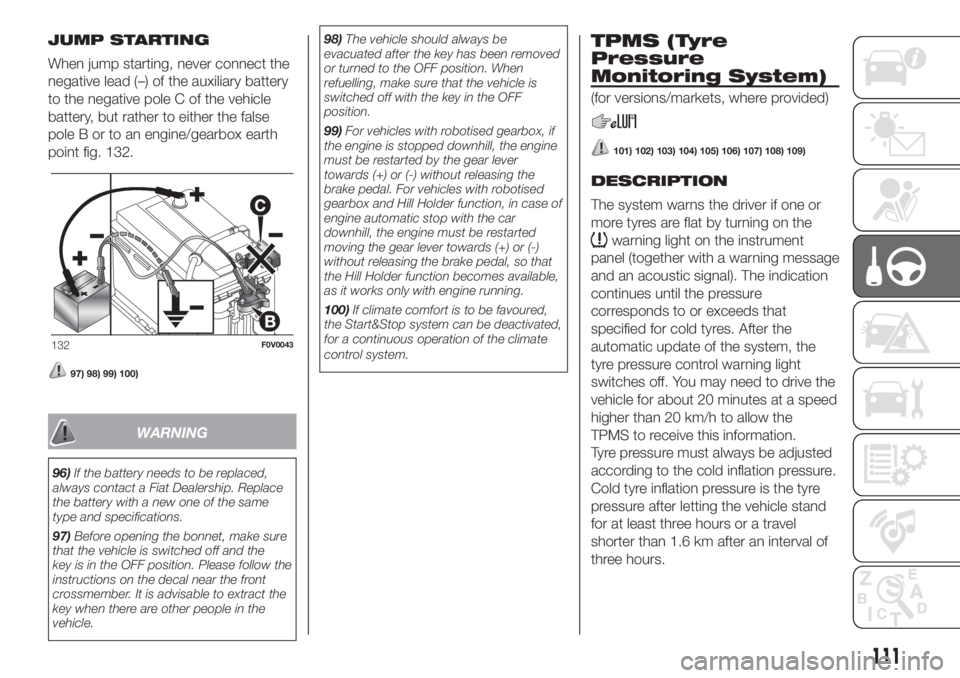
JUMP STARTING
When jump starting, never connect the
negative lead (–) of the auxiliary battery
to the negative pole C of the vehicle
battery, but rather to either the false
pole B or to an engine/gearbox earth
point fig. 132.
97) 98) 99) 100)
WARNING
96)If the battery needs to be replaced,
always contact a Fiat Dealership. Replace
the battery with a new one of the same
type and specifications.
97)Before opening the bonnet, make sure
that the vehicle is switched off and the
key is in the OFF position. Please follow the
instructions on the decal near the front
crossmember. It is advisable to extract the
key when there are other people in the
vehicle.98)The vehicle should always be
evacuated after the key has been removed
or turned to the OFF position. When
refuelling, make sure that the vehicle is
switched off with the key in the OFF
position.
99)For vehicles with robotised gearbox, if
the engine is stopped downhill, the engine
must be restarted by the gear lever
towards (+) or (-) without releasing the
brake pedal. For vehicles with robotised
gearbox and Hill Holder function, in case of
engine automatic stop with the car
downhill, the engine must be restarted
moving the gear lever towards (+) or (-)
without releasing the brake pedal, so that
the Hill Holder function becomes available,
as it works only with engine running.
100)If climate comfort is to be favoured,
the Start&Stop system can be deactivated,
for a continuous operation of the climate
control system.
TPMS (Tyre
Pressure
Monitoring System)
(for versions/markets, where provided)
101) 102) 103) 104) 105) 106) 107) 108) 109)
DESCRIPTION
The system warns the driver if one or
more tyres are flat by turning on the
warning light on the instrument
panel (together with a warning message
and an acoustic signal). The indication
continues until the pressure
corresponds to or exceeds that
specified for cold tyres. After the
automatic update of the system, the
tyre pressure control warning light
switches off. You may need to drive the
vehicle for about 20 minutes at a speed
higher than 20 km/h to allow the
TPMS to receive this information.
Tyre pressure must always be adjusted
according to the cold inflation pressure.
Cold tyre inflation pressure is the tyre
pressure after letting the vehicle stand
for at least three hours or a travel
shorter than 1.6 km after an interval of
three hours.
132F0V0043
111
Page 182 of 272
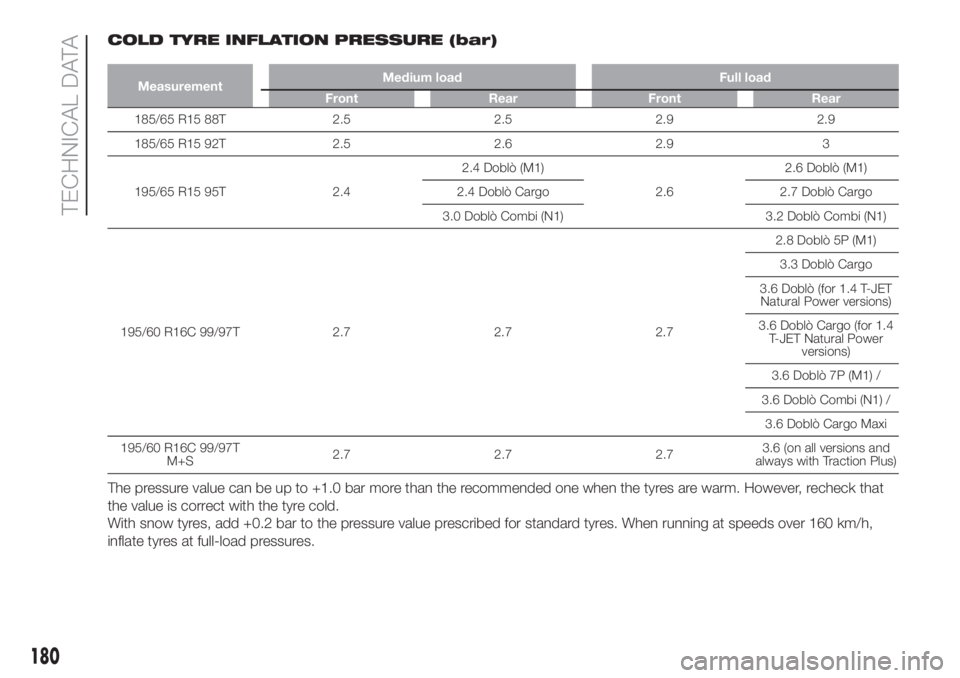
COLD TYRE INFLATION PRESSURE (bar)
MeasurementMedium load Full load
Front Rear Front Rear
185/65 R15 88T 2.5 2.5 2.9 2.9
185/65 R15 92T 2.5 2.6 2.9 3
195/65 R15 95T 2.42.4 Doblò (M1)
2.62.6 Doblò (M1)
2.4 Doblò Cargo 2.7 Doblò Cargo
3.0 Doblò Combi (N1) 3.2 Doblò Combi (N1)
195/60 R16C 99/97T 2.7 2.7 2.72.8 Doblò 5P (M1)
3.3 Doblò Cargo
3.6 Doblò (for 1.4 T-JET
Natural Power versions)
3.6 Doblò Cargo (for 1.4
T-JET Natural Power
versions)
3.6 Doblò 7P (M1) /
3.6 Doblò Combi (N1) /
3.6 Doblò Cargo Maxi
195/60 R16C 99/97T
M+S2.7 2.7 2.73.6 (on all versions and
always with Traction Plus)
The pressure value can be up to +1.0 bar more than the recommended one when the tyres are warm. However, recheck that
the value is correct with the tyre cold.
With snow tyres, add +0.2 bar to the pressure value prescribed for standard tyres. When running at speeds over 160 km/h,
inflate tyres at full-load pressures.
180
TECHNICAL DATA
Page 213 of 272

.
VERSIONS CONSUMPTION
2.0 Multijet Euro 5+ TREKKING Urban Extra-urban Combined
Combi 5-seater Short Wheelbase Low Roof - No
Start&Stop7.3 5.2 6.0
Combi 5-seater Short Wheelbase Low Roof - No
Start&Stop - Reinforced suspension7.3 5.2 6.0
.
VERSIONS CONSUMPTION
2.0 MultiJet 135 HP Euro 5 / Euro 5+ NO Start&Stop Urban Extra-urban Combined
Cargo short wheelbase / Cargo short wheelbase,
increased payload / Cargo long wheelbase7.2 5.1 5.9
Combi 5-seater, short wheelbase / Combi 5-seater, long
wheelbase / Doblò 5/7-seater7.3 5.1 5.9
Cargo, short wheelbase, high roof, increased payload /
Cargo short wheelbase, high roof7.8 5.5 6.3
Cargo, short wheelbase, high roof / increased payload /
Doblò 5-seater, high roof7.4 5.5 6.2
Combi 5-seater, long wheelbase, high roof 7.8 5.5 6.3
Cargo, long wheelbase, high roof 7.4 5.5 6.2
Doblò 5-seater, long wheelbase 7.3 5.1 5.9
Flatbed, short wheelbase / long wheelbase, low roof 7.8 6.6 7.0
.
NOTE The consumption values of the Natural Power versions when running on methane are indicated in m3/100 km.
211
Page 225 of 272
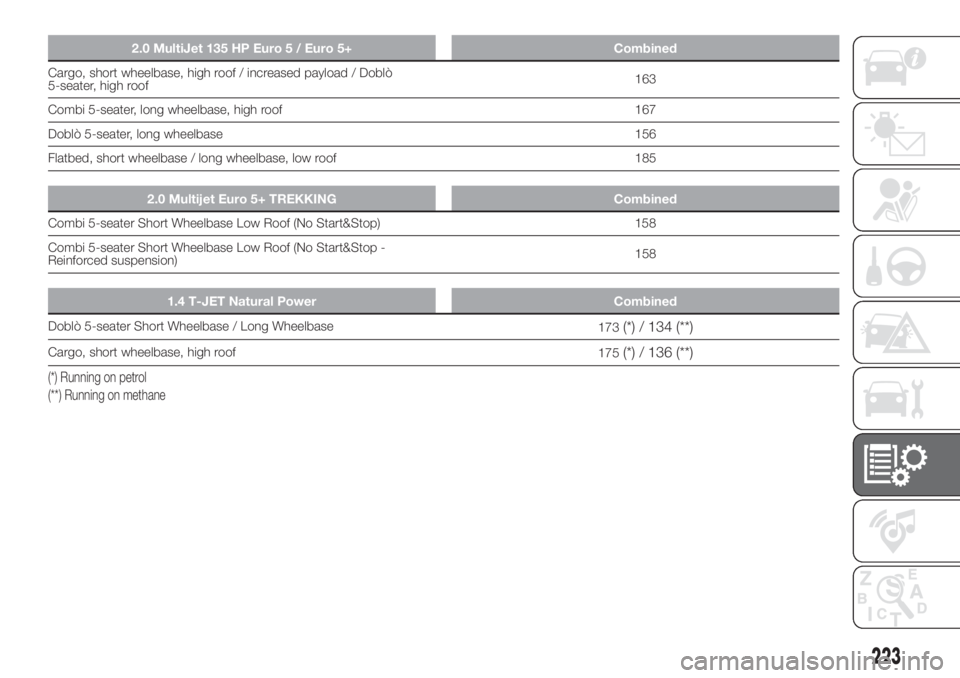
2.0 MultiJet 135 HP Euro 5 / Euro 5+ Combined
Cargo, short wheelbase, high roof / increased payload / Doblò
5-seater, high roof163
Combi 5-seater, long wheelbase, high roof 167
Doblò 5-seater, long wheelbase 156
Flatbed, short wheelbase / long wheelbase, low roof 185
2.0 Multijet Euro 5+ TREKKING Combined
Combi 5-seater Short Wheelbase Low Roof (No Start&Stop) 158
Combi 5-seater Short Wheelbase Low Roof (No Start&Stop -
Reinforced suspension)158
1.4 T-JET Natural Power Combined
Doblò 5-seater Short Wheelbase / Long Wheelbase
173(*) / 134 (**)
Cargo, short wheelbase, high roof
175(*) / 136 (**)
(*) Running on petrol
(**) Running on methane
223
Page 267 of 272
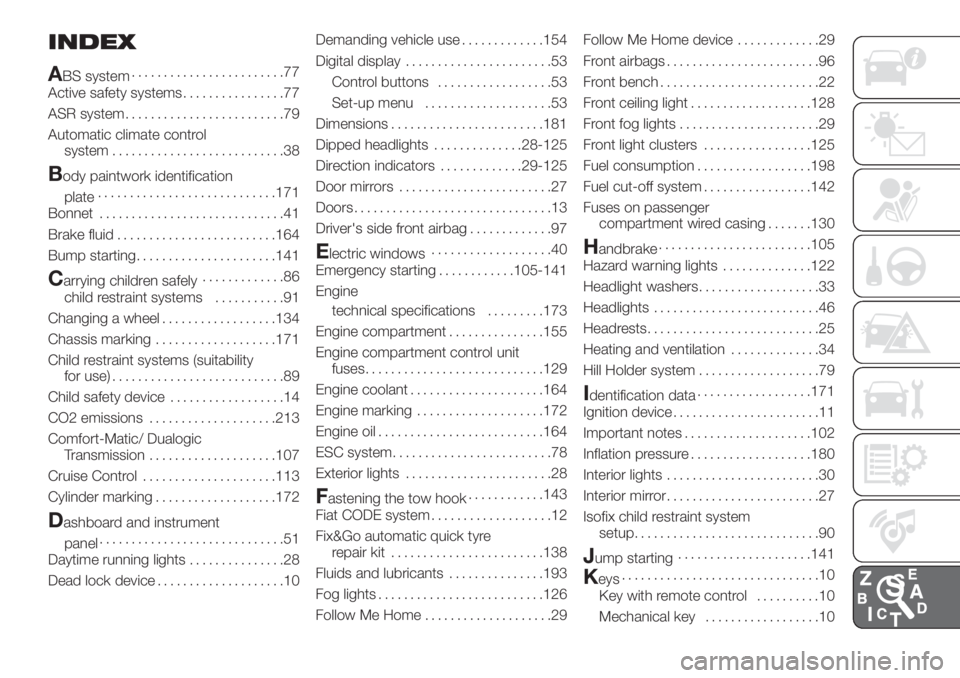
INDEX
A
BS system........................77
Active safety systems................77
ASR system.........................79
Automatic climate control
system...........................38
Body paintwork identification
plate............................171
Bonnet.............................41
Brake fluid.........................164
Bump starting......................141
Carrying children safely.............86
child restraint systems...........91
Changing a wheel..................134
Chassis marking...................171
Child restraint systems (suitability
for use)...........................89
Child safety device..................14
CO2 emissions....................213
Comfort-Matic/ Dualogic
Transmission....................107
Cruise Control.....................113
Cylinder marking...................172
Dashboard and instrument
panel.............................51
Daytime running lights...............28
Dead lock device....................10Demanding vehicle use.............154
Digital display.......................53
Control buttons..................53
Set-up menu....................53
Dimensions........................181
Dipped headlights..............28-125
Direction indicators.............29-125
Door mirrors........................27
Doors...............................13
Driver's side front airbag.............97
Electric windows...................40
Emergency starting............105-141
Engine
technical specifications.........173
Engine compartment...............155
Engine compartment control unit
fuses............................129
Engine coolant.....................164
Engine marking....................172
Engine oil..........................164
ESC system.........................78
Exterior lights.......................28
Fastening the tow hook............143
Fiat CODE system...................12
Fix&Go automatic quick tyre
repair kit........................138
Fluids and lubricants...............193
Fog lights..........................126
Follow Me Home....................29Follow Me Home device.............29
Front airbags........................96
Front bench.........................22
Front ceiling light...................128
Front fog lights......................29
Front light clusters.................125
Fuel consumption..................198
Fuel cut-off system.................142
Fuses on passenger
compartment wired casing.......130
Handbrake........................105
Hazard warning lights..............122
Headlight washers...................33
Headlights..........................46
Headrests...........................25
Heating and ventilation..............34
Hill Holder system...................79
Identification data..................171
Ignition device.......................11
Important notes....................102
Inflation pressure...................180
Interior lights........................30
Interior mirror........................27
Isofix child restraint system
setup.............................90
Jump starting.....................141
Keys...............................10
Key with remote control..........10
Mechanical key..................10